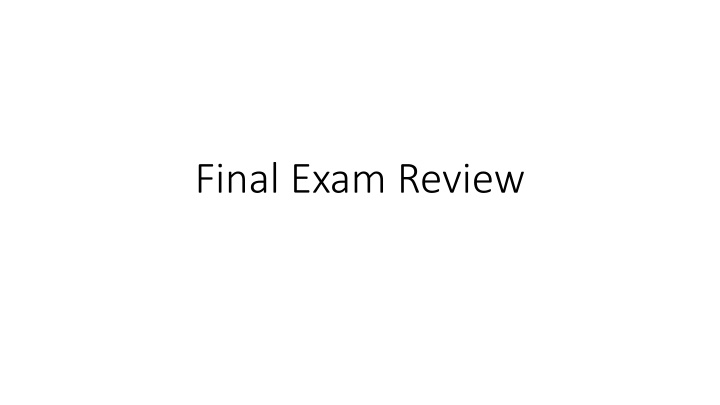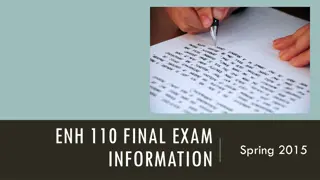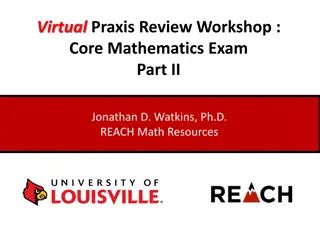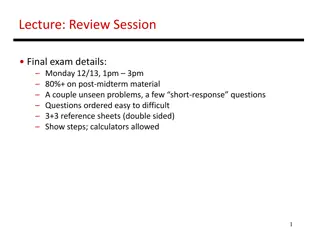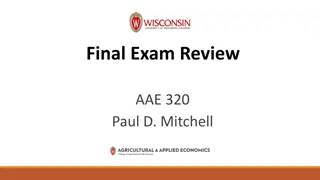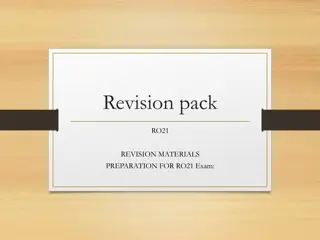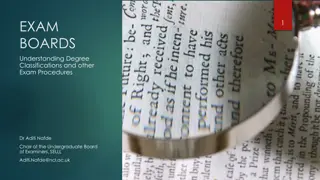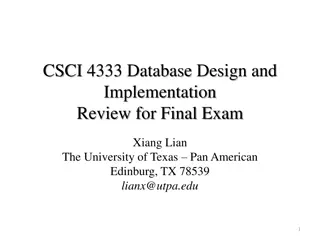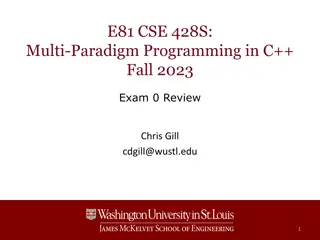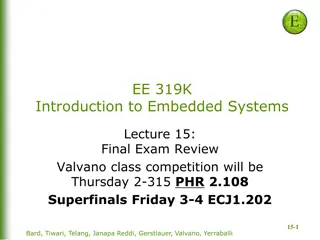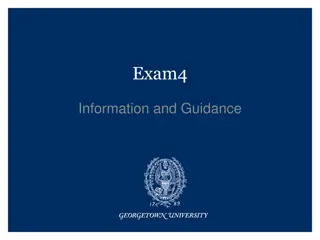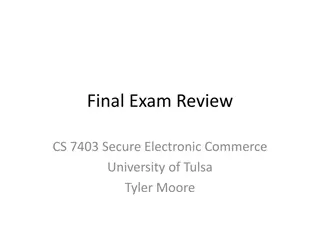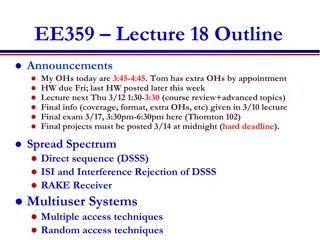Final Exam Review and Topics for Success
Prepare for your upcoming final exam with detailed information on a lunar occultation of Mars and essential topics to study. Learn about gravitational waves, radioactive decay, and gravitational red shift calculations. Utilize study guides and previous exam reviews to excel in your exam. Don't miss the opportunity to boost your knowledge and ace your finals!
Download Presentation

Please find below an Image/Link to download the presentation.
The content on the website is provided AS IS for your information and personal use only. It may not be sold, licensed, or shared on other websites without obtaining consent from the author.If you encounter any issues during the download, it is possible that the publisher has removed the file from their server.
You are allowed to download the files provided on this website for personal or commercial use, subject to the condition that they are used lawfully. All files are the property of their respective owners.
The content on the website is provided AS IS for your information and personal use only. It may not be sold, licensed, or shared on other websites without obtaining consent from the author.
E N D
Presentation Transcript
Lunar occultation of Mars The Moon will pass in front of Mars, creating a lunar occultation visible from parts of the Americas, Europe and Northern Africa. Lunar occultations are only ever visible from a small fraction of the Earth's surface. Since the Moon is much closer to the Earth than other celestial objects, this occasion, the occultation will be visible from College Station. It will begin with theOn disappearance of Mars behind the Moon at 21:01 CSTin the eastern sky at an altitude of 47.1 degrees. Its reappearance will be visible at 21:15 CSTat an altitude of 50.1 degrees. An illustration of the night sky on Dec. 07 showing the full Cold Moon occulting Mars
Topics and What to Study Exam time and date: Friday, Dec. 9th from 7:30am to 9:30am on Canvas Exam will be made up of 30 multiple choice questions Not all questions worth the same amount of points Majority of content will come from most recent chapters Remaining content will come from rest of the semester Review previous final exam posted on SIBOR Use study guide given on SIBOR
1. A large Michelson interferometer consisting of orthogonal optical cavities, where each cavity has a length of 10 km is used to detect gravitational waves. The maximum amplitude of strain (or fractional change in length) measured by the detectors was 10 21. What was the maximum change in length (in m) of the optical cavity due to the gravitational wave? (For comparison, the radius of a proton is about 10 15 m.) 10km L = 10-21 (Not to scale) ? ?= 10 21= A ? = ? ? ? = 10 21 104(m) 10km ? = 10 17(?)
2. A radioactive sample of 60Co (t1/2= 5.271y) has a - activity of 2 x 107 Bq. How many grams of 60Co are present? =ln(2) ?1/2 ? =ln(2) ? = ?0 ?0 ?1/2 ?1/2 ln 2 ? =?0 ?1/2= 5.271 y = 1.662E8 s ??? ?0= ? ?? ?= 2E7 Bq = 2E7 particle/s ?0= 4.796E15 ??= 6.023E23 atoms/mole ?0 ?? ??? ? = ? = 4.778E 7 g
3. An airplane flies at 300 m/s with an altitude of 104 m and circles the world. It flies for a total of 45 hours. Calculate the gravitational red shift of a clock on the airplane assuming the airplane speed remains 300 m/s. Assume the circumference of the earth is 4E7 (m), the acceleration due to gravity is 9.8 m/s2, and the speed of light c=3E8 m/s. ? ? = ? ?=?? 1 ?2 1 ??????????? ???? ???: ? =? ? General form: ?2 ?1 ?2 ? ? ? ? = ? 1.09? 12 =? ? H = 104 m = 1.09? 12 ?2 T = 45 hr = 1.62E5 s ? = 177E-9 s Approximation by Power Series 1 ?2 1 1 2?2 Special Relativity Time Dilation: ??=?0 ? = ?0 ?? = ?0 ?0 = ?01 1 1 ? =? ? D = 4E7m 1 ?2 ? ?= 1.33E5 s T0= 1.33E5 s V=300 m/s T0=? 2?2 ? =3?2 3?8= 1? 6 1 2?2 = ?0 ? = 6.65E-8 s = 66.5 ns
4. A gravitational wave signal was the result of two black holes, orbiting around a common center of mass, which spiraled inward and merged to form a single black hole. The mass of the first black hole was 40 solar masses, and the second was 30 solar masses. The final black hole mass after the merger was 60 solar masses. The entire detected signal lasted about 20 seconds. What was the average power (in W) radiated away as gravitational waves during this time? (Take one solar mass to be 2E30 kg.) M1 = 40 M2 = 30 Mf = 60 T = 20s M = (M1 + M2) Mf = 10 E = mc2= ( M)c2 = (10*2E30 kg)*(3E8 m/s2)2 E = 1.8E48 J P = ? ?= 9E46W
